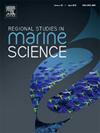Acute and chronic sources of polycyclic aromatic hydrocarbons (PAHs) in coastal sediments impacted by the 2019–2020 oil spill in NE Brazil
IF 2.4
4区 环境科学与生态学
Q3 ECOLOGY
引用次数: 0
Abstract
The 2019–2020 oil spill off the Brazilian coast represents one of the largest environmental disasters in the South Atlantic, impacting diverse ecosystems and vulnerable communities. This study investigates the occurrence, levels, composition, and potential ecological risks of polycyclic aromatic hydrocarbons (PAHs) in surface sediments of mangroves affected by the spill along the coast of Bahia, NE Brazil. Fifty-one samples were collected across seven sites, including oil-impacted areas, a control site, and a chronically contaminated area, during three campaigns conducted 12, 18, and 24 months after the spill. Total PAH concentrations (∑16 PAHs) ranged from 39.1 to 595.4 ng g⁻¹ and fell within low to moderate contamination levels. Despite a general decreasing trend over time, spatial and temporal patterns were inconsistent, and PAH distributions appeared to be influenced by both the oil spill and local anthropogenic inputs. Higher alkyl-PAHs/parent-PAHs ratios in Siribinha and Boipeba suggest a long-term influence of petrogenic sources linked to the oil spill, while elevated PAHs in the São Paulo River reflect chronic industrial and urban pollution. Diagnostic ratios and compositional profiles confirmed mixed pyrogenic and petrogenic signatures across sites. Although mean sediment quality guideline quotients indicated low ecotoxicological risk overall, exceedances of threshold values for acenaphthylene and phenanthrene at some sites, particularly those inhabited by traditional communities, highlight the importance of continued monitoring. This study provides the first spatially and temporally resolved assessment of PAH contamination in mangrove sediments following the 2019–2020 oil spill, contributing to a broader understanding of both acute and chronic hydrocarbon impacts in tropical coastal ecosystems.
受2019-2020年巴西东北部溢油影响的沿海沉积物中多环芳烃(PAHs)的急性和慢性来源
2019-2020年巴西海岸漏油事件是南大西洋最大的环境灾难之一,影响了各种生态系统和脆弱社区。本研究调查了巴西东北部巴伊亚沿岸受泄漏影响的红树林表层沉积物中多环芳烃(PAHs)的发生、水平、组成和潜在的生态风险。在泄漏后12、18和24个月进行的三次活动中,在七个地点收集了51个样本,包括受石油影响的地区、一个控制地点和一个长期污染的地区。总多环芳烃浓度(∑16 PAHs)范围为39.1至595.4 ng g⁻¹,属于中低污染水平。尽管随着时间的推移,多环芳烃的分布总体呈下降趋势,但空间和时间格局不一致,多环芳烃的分布似乎同时受到溢油和当地人为输入的影响。Siribinha和Boipeba的烷基多环芳烃/母体多环芳烃比率较高,表明与石油泄漏有关的成岩源的长期影响,而圣保罗河中多环芳烃的升高反映了长期的工业和城市污染。诊断比率和成分剖面证实了不同地点的混合热成因和岩石成因特征。虽然平均沉积物质量准则商总体上表明生态毒理学风险较低,但在一些地点,特别是传统社区居住的地点,苊和菲的阈值超过了阈值,突出了继续监测的重要性。该研究首次提供了2019-2020年石油泄漏后红树林沉积物中多环芳烃污染的时空解决评估,有助于更广泛地了解热带沿海生态系统中碳氢化合物的急性和慢性影响。
本文章由计算机程序翻译,如有差异,请以英文原文为准。
求助全文
约1分钟内获得全文
求助全文
来源期刊

Regional Studies in Marine Science
Agricultural and Biological Sciences-Ecology, Evolution, Behavior and Systematics
CiteScore
3.90
自引率
4.80%
发文量
336
审稿时长
69 days
期刊介绍:
REGIONAL STUDIES IN MARINE SCIENCE will publish scientifically sound papers on regional aspects of maritime and marine resources in estuaries, coastal zones, continental shelf, the seas and oceans.
 求助内容:
求助内容: 应助结果提醒方式:
应助结果提醒方式:


